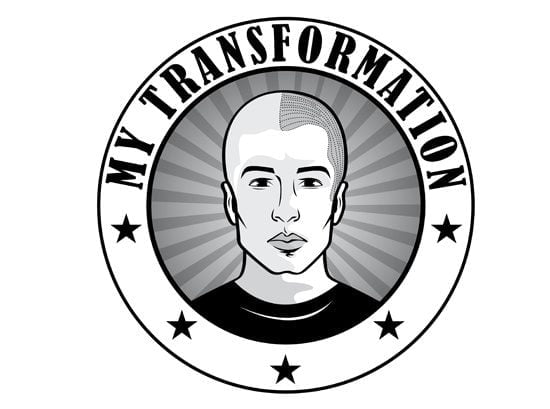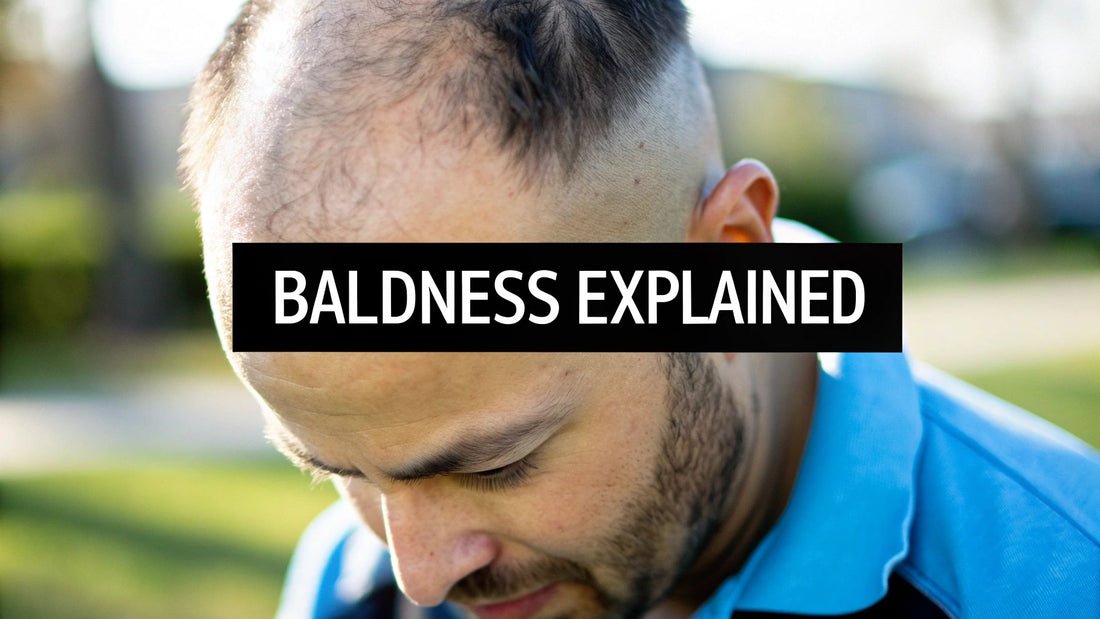
What Causes Male Pattern Baldness Explained
Share
So, what’s really going on with male pattern baldness? Clinically, it's called androgenetic alopecia, and it’s not as mysterious as it might seem. At its core, it’s a one-two punch of your genetic makeup and a specific hormone called dihydrotestosterone (DHT).
If you’ve inherited genes that make your hair follicles particularly sensitive, DHT can bind to them. This triggers a process where the follicles shrink over time, eventually reaching a point where they can no longer produce hair.
The Real Causes of Male Pattern Baldness
Let's cut through the noise. Male pattern baldness isn't caused by wearing a hat too often or using the "wrong" shampoo. The truth is, it boils down to a powerful interaction between your genes and your hormones.
Think of it like this: your hair follicles have tiny receptors, almost like a lock. DHT is the key. If your genetics have built a lock that this key fits perfectly, DHT can latch on and tell the follicle to start shutting down.
This shrinking process is called ‘miniaturisation’. With each growth cycle, the hair that comes back is a little thinner, a little shorter, and a little weaker. Eventually, the follicle just gives up and stops producing hair altogether. This is the fundamental reason behind a receding hairline or a thinning crown.
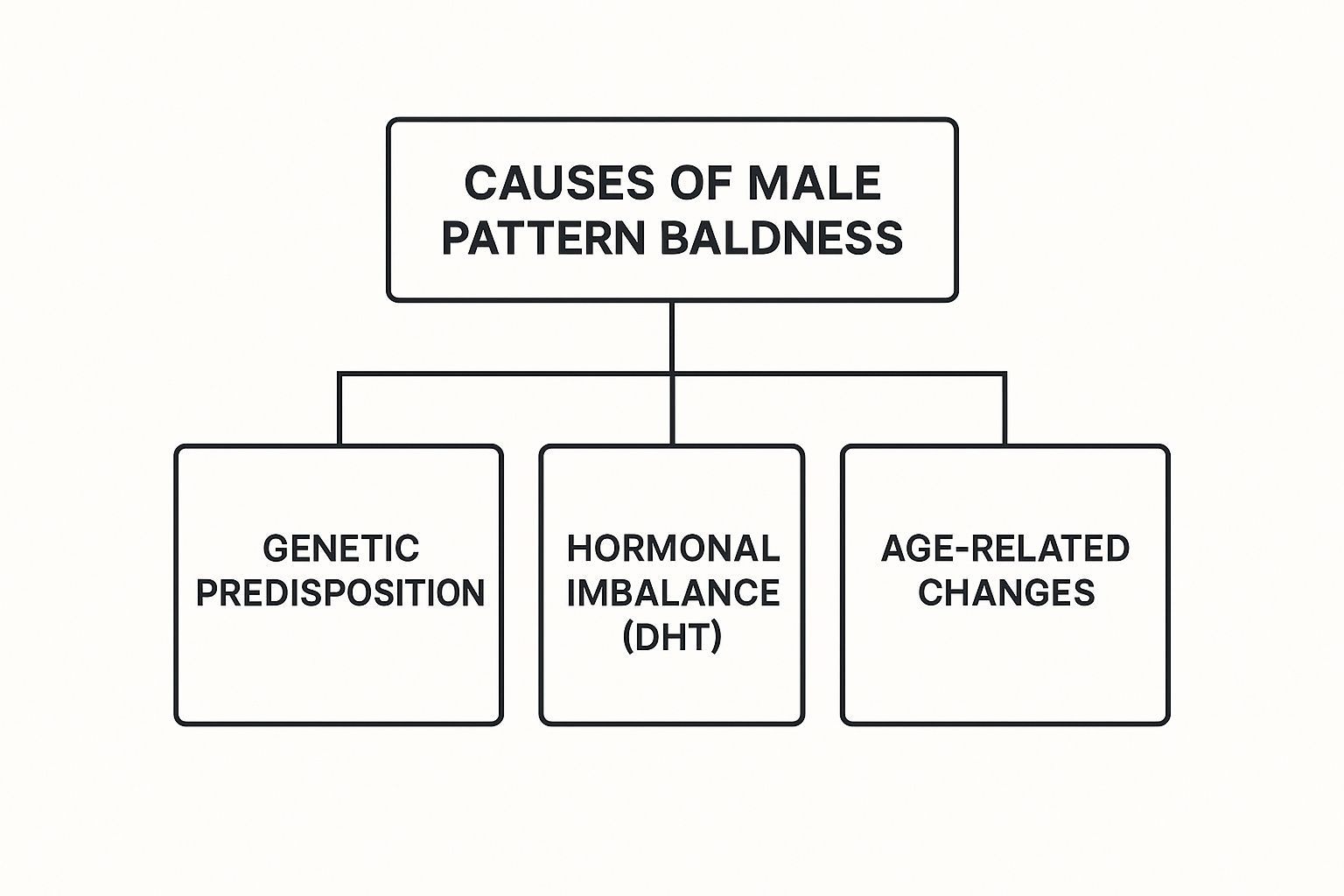
As the diagram shows, it's really the combination of genetics and hormones that lays the groundwork. Age then acts as an amplifier, making the effects more visible over the years. It’s a progressive condition, which is why you notice it getting worse over time.
Understanding the Key Drivers
Just how common is this? Here in Australia, male pattern baldness affects nearly half of all men over 40. It’s a hereditary condition passed down through your family line, and unfortunately, it's largely unavoidable if you have the right genetic lottery ticket.
The main contributors can be broken down into three core areas:
- Your Genetic Blueprint: You inherit genes from both your parents that dictate how sensitive your hair follicles will be to hormones, especially DHT.
- Hormonal Influence: An enzyme called 5-alpha reductase exists in your body, and its job is to convert testosterone into DHT. This is the hormone that does the damage.
- The Ageing Process: As we get older, our hair’s natural growth cycle naturally begins to slow down. This makes the follicle-shrinking effects of genetics and DHT far more obvious.
It's crucial to understand this isn't about what you do on the outside. The process is internal, driven entirely by your unique genetic and hormonal profile.
To give you a quick reference, here’s a simple breakdown of the primary factors at play.
Key Factors Causing Male Pattern Baldness at a Glance
| Factor | Role in Hair Loss |
|---|---|
| Genetics | Determines the sensitivity of your hair follicles to androgen hormones like DHT. Inherited from both parents. |
| Hormones (DHT) | Dihydrotestosterone (DHT) binds to sensitive follicles, causing them to shrink and stop producing hair. |
| Enzyme (5-alpha reductase) | This enzyme converts testosterone into DHT, the primary catalyst for miniaturisation. |
| Age | The natural ageing process shortens the hair growth cycle, making the effects of DHT more pronounced over time. |
This table neatly summarises the internal chain reaction that leads to hair loss.
Getting a handle on why men suffer from male pattern hair loss is the first, most important step toward finding a solution that actually works. Now, let's dive deeper into each of these causes to give you a complete picture of the science behind what's happening on your head.
How Your Family Tree Shapes Your Hairline

When you're trying to figure out what’s causing male pattern baldness, your family history is always the first place to look. It’s the single biggest clue. While hormones like DHT are the direct culprits doing the work, it's your genes that are pulling the strings behind the scenes. They essentially hand out the instruction manual telling your hair follicles how to react.
Think of it as a genetic recipe you inherit. You get a mix of ingredients—your genes—from both parents, and that specific combination dictates your hair's destiny. There's a persistent myth that baldness only comes from your mother's side, but the reality is far more complicated than that.
You can inherit the critical genes for hair loss from either your mum or your dad. This explains why hair loss can sometimes seem to skip a generation, or why it might run rampant on one side of the family and not the other.
The Genetic Lottery Explained
At the very core of this genetic puzzle is a key player known as the Androgen Receptor (AR) gene. This gene is responsible for creating the receptors on your hair follicles that DHT latches onto. Certain variations of this gene can make these receptors way too sensitive.
Let's use an analogy. Imagine your hair follicles are covered in little docking stations (the receptors), and DHT molecules are like ships trying to park. If your specific version of the AR gene builds super-efficient, perfectly shaped docking stations, more of those DHT ships can successfully attach and deliver their signal to shrink the follicle.
Here's the kicker: it’s not just one "baldness gene." Hair loss is what we call a polygenic trait. This means many different genes work together to determine your risk. In fact, scientists have pinpointed over 200 genetic variants that all have a small part to play.
This is why the pattern and speed of hair loss can vary so dramatically, even between brothers who share a lot of the same DNA. Everyone gets a completely unique shuffle of the genetic cards.
How Genes Dictate Follicle Sensitivity
So, what does this all mean for the hair on your head? It all boils down to sensitivity. Two blokes could have the exact same level of DHT in their blood, yet one might be losing his hair while the other still has a full mop. The difference is purely down to their genetic programming.
- High Genetic Sensitivity: If you inherit a strong genetic tendency for hair loss, even completely normal levels of DHT can kickstart the follicle-shrinking process, leading to earlier or more severe balding.
- Low Genetic Sensitivity: On the flip side, if your genes make your receptors less sensitive, your follicles can tough it out against DHT's effects, even if your hormone levels are on the higher side.
Ultimately, your family tree lays out the blueprint. You can't change the genes you were born with, but understanding the powerful role they play is the first step. It makes it clear that male pattern baldness is a medical condition written into your DNA, not something you did wrong. This genetic foundation sets the stage for the hormonal process that actually causes the hair to thin.
Understanding DHT: The Hormone That Shrinks Hair
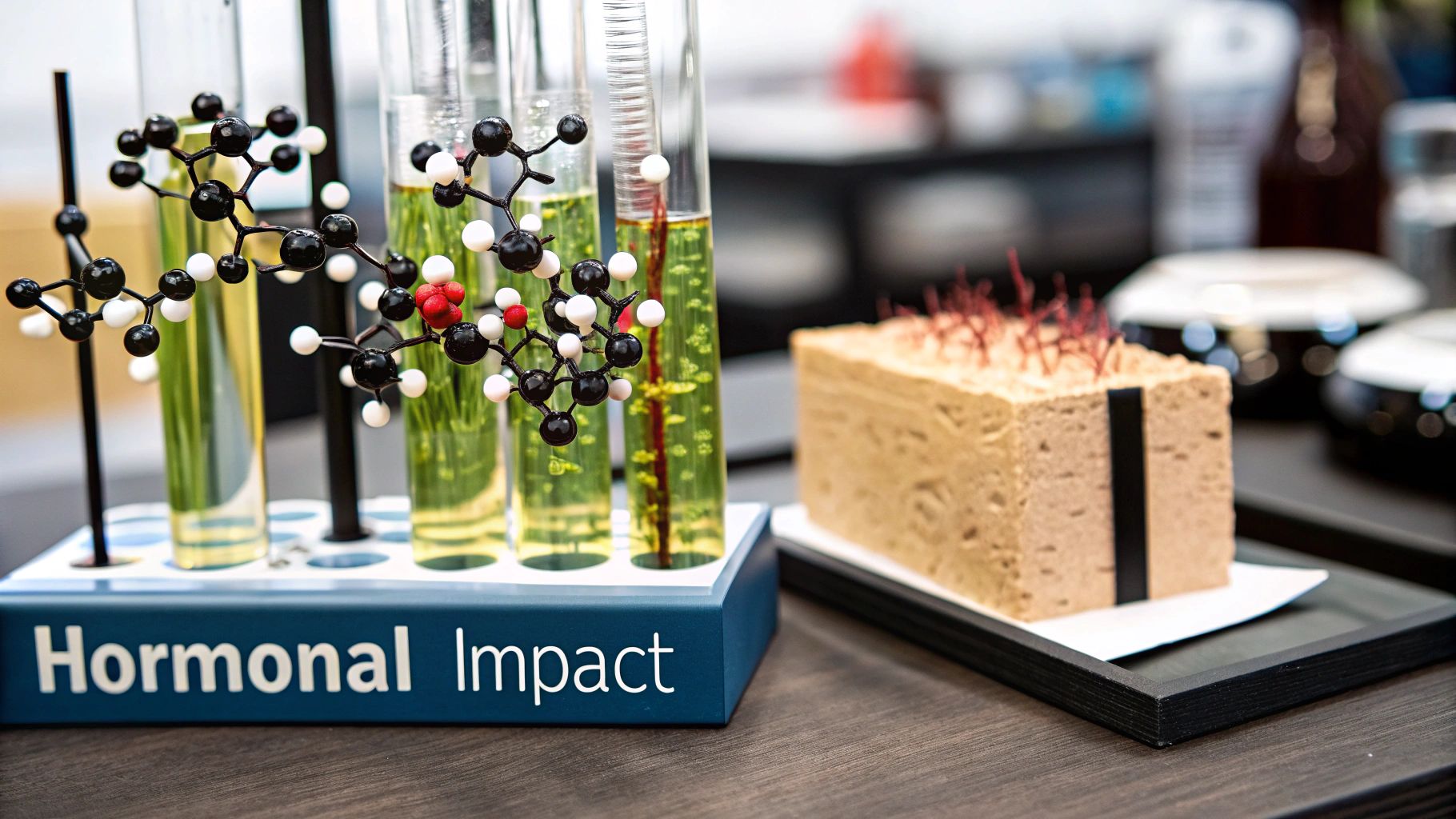
While your genes might load the gun for hair loss, it’s a powerful hormone called dihydrotestosterone (DHT) that actually pulls the trigger. Think of DHT as the key hormonal culprit behind male pattern baldness—it’s the chemical messenger that instructs genetically sensitive hair follicles to start shutting down.
But DHT isn’t some foreign invader. It's a natural substance made inside your body. An enzyme named 5-alpha reductase has the job of converting a small portion of your testosterone into this more potent androgen.
This conversion happens in men all the time and is completely normal. The problem only starts when your hair follicles have been genetically programmed to be overly sensitive to DHT's effects.
The Miniaturisation Process Explained
To get a clear picture of what DHT does, imagine a healthy, thriving plant in your garden. Now, picture someone slowly but surely pinching the hose that waters it. At first, the plant might look okay, but over time, it gets less and less nourishment. It becomes weaker, its leaves get smaller, and eventually, it just withers away.
That's an almost perfect analogy for what DHT does to a vulnerable hair follicle. This process is called ‘miniaturisation’.
When DHT latches onto a sensitive follicle's receptor, it shortens the hair's growth phase (known as the anagen phase). With each new growth cycle, the follicle spends less time growing and more time resting. The result?
- Thinner Hairs: Each new strand that grows back is finer and less pigmented than the one before it.
- Shorter Hairs: The growth phase gets cut short, meaning the hair can't reach its previous length.
- Eventual Dormancy: After many cycles of this, the follicle shrinks so much that it can no longer produce a visible hair. It simply goes dormant.
This gradual shrinking is why male pattern baldness is a progressive condition. It doesn’t happen overnight. It’s a slow, steady process of follicles producing increasingly weaker hairs until they stop altogether.
The Conversion of Testosterone to DHT
This conversion from testosterone to DHT is the critical chemical step that kicks off the entire chain reaction. The 5-alpha reductase enzyme is found in various tissues, including the oil glands of your hair follicles, which is why DHT's effects are so localised to the scalp.
This process is incredibly common. For instance, recent figures show that roughly 40% to 41% of Australian men over 40 are dealing with some degree of baldness. This hair loss almost always follows the classic DHT-driven pattern: a receding hairline and a thinning crown.
It’s this localised conversion on the scalp that creates the distinct patterns we all recognise as male pattern baldness. While other factors like stress can cause general shedding, they don’t cause this specific, patterned hair loss. If you’re curious about other potential causes, our guide on stress-related hair loss is a great resource.
Still, understanding the root hormonal cause is the essential first step toward finding a solution that actually works.
Can Lifestyle Choices Speed Up Hair Loss?
While your genes and hormones are the main culprits behind male pattern baldness, they don't tell the full story. Think of your daily habits and environment as accelerators on a car – they can seriously speed up the journey down a road you were already destined to travel.
You can't rewrite your genetic code, but you absolutely have a say in the external factors that influence your hair's health. The goal here isn’t to point fingers, but to give you the knowledge to create a healthier environment for your hair, even if the genetic odds are stacked against you.
Stress and Nutrition: The Internal Battle
Chronic stress is a huge player in this game. When you're constantly on edge, your body pumps out a hormone called cortisol. High levels of cortisol can throw your hair's natural growth cycle out of whack, forcing more follicles into the resting phase (telogen) way too soon. This leads to more shedding, which can make genetically thinning hair look much worse, much faster.
It's a similar story with poor nutrition. A diet missing key nutrients like iron, zinc, and protein basically starves your hair follicles of the raw materials they need to build strong hair. Just like a high-performance car needs premium fuel, your hair needs quality nourishment to grow properly.
While lifestyle factors on their own won't cause androgenetic alopecia, they can definitely unmask it or make it worse. A high-stress lifestyle paired with a nutrient-poor diet creates a hostile environment for hair follicles already fighting a losing battle against DHT.
Living in Australia also adds a unique set of challenges. Our famously high ultraviolet (UV) exposure can damage both the scalp and the hair follicles themselves, potentially accelerating hair loss. Add in the stress from demanding work cultures and long commutes, and you've got another layer of complexity to deal with.
Daily Habits That Can Make a Difference
Some of your everyday choices might be having a bigger impact than you realise. Smoking, for instance, is a major offender. It constricts your blood vessels, which chokes off blood flow to the scalp and deprives your follicles of the oxygen and nutrients they desperately need.
To make this clearer, let's break down how some common lifestyle habits can tip the scales.
Lifestyle Factors and Their Impact on Hair Health
This table shows how certain daily choices can put extra pressure on hair follicles that are already genetically vulnerable.
| Factor | Potential Impact on Hair Follicles | Example |
|---|---|---|
| Chronic Stress | Increases cortisol, which can disrupt the hair growth cycle and trigger shedding. | A high-pressure job leading to constant anxiety and noticeable hair thinning over a few months. |
| Poor Nutrition | Deprives follicles of essential nutrients like iron, zinc, and protein needed for growth. | A diet heavy in processed foods and low in fresh produce, resulting in weaker, brittle hair. |
| Smoking | Restricts blood flow to the scalp, starving follicles of oxygen and vital nutrients. | A long-term smoker noticing their hairline is receding faster than their non-smoking family members. |
As you can see, these aren't just minor influences; they can have a real, tangible effect on your hair's future.
Making positive changes in these areas is a powerful way to support your overall scalp health. By focusing on smart stress management and a balanced diet, you can create the best possible conditions for your hair to thrive. In fact, learning how to stop hair loss often means taking a holistic approach that tackles these lifestyle factors right alongside proven treatments.
Why Hair Loss Gets Worse with Age
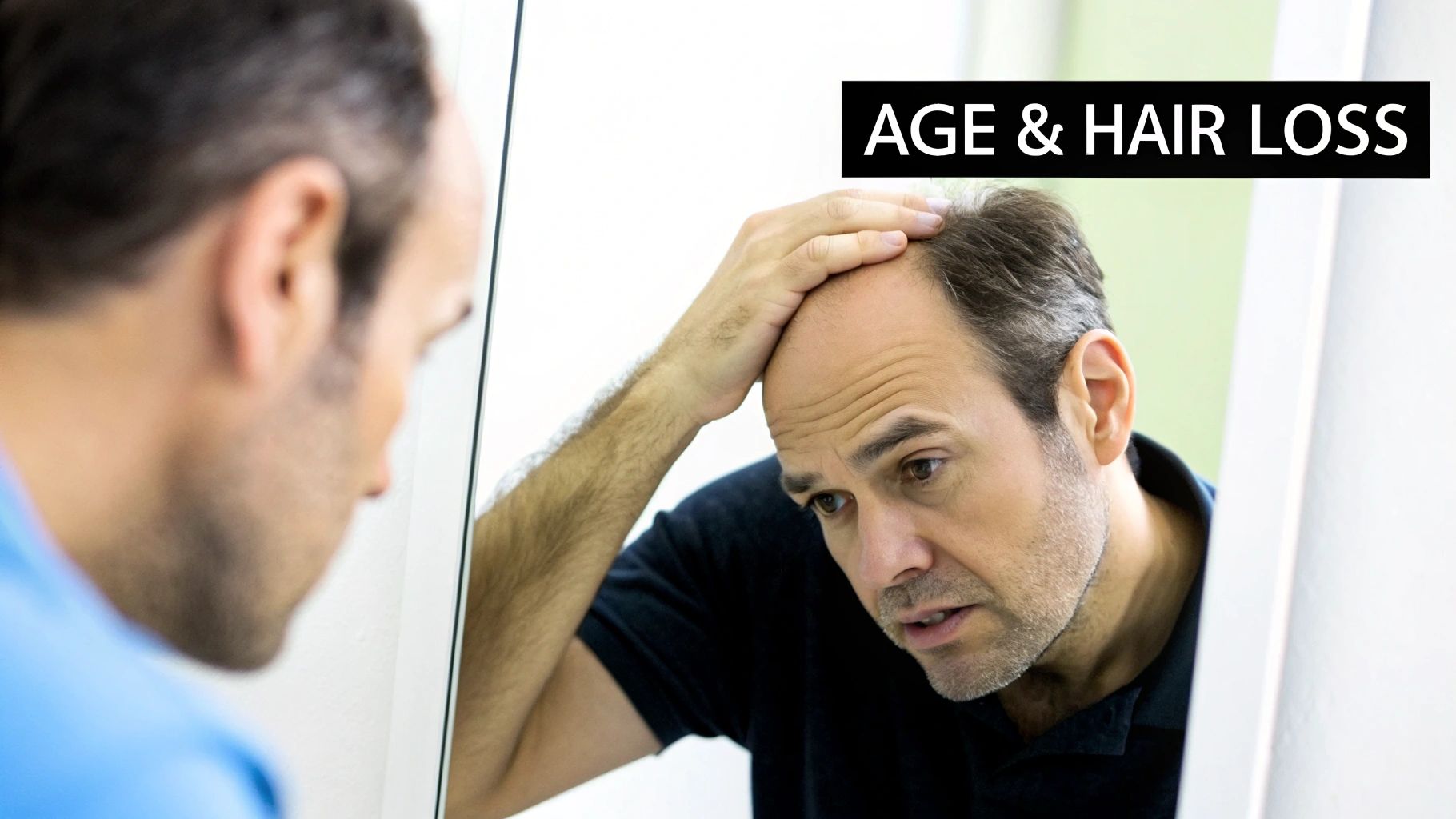
It’s a fair question we hear all the time: if you've had the genes for baldness since birth, why does it only really kick in as you get older? The answer is a bit of a tag-team effort between your genes, hormones, and the natural process of ageing.
Every hair on your head goes through a life cycle, and the most important part of that is the growth stage, known as the anagen phase. When you're younger, this phase is long and strong, churning out thick, healthy hair for years at a time. As we get older, however, that growth phase naturally starts to get shorter. This happens to everyone.
But for men who are genetically sensitive to DHT, this normal, age-related slowdown creates the perfect storm for rapid hair loss. Your follicles are now getting hit from two different directions.
The Combined Forces of Age and DHT
Think of it like a battle. On one side, you have DHT constantly weakening your hair follicles. On the other, you have the natural ageing process, which reduces the follicles' ability to bounce back and grow.
In your younger years, your hair follicles can put up a pretty good fight against the hormonal onslaught. But as time goes on and ageing shortens that critical growth window, the damage from DHT really starts to add up and become visible. That subtle thinning you might have brushed off in your 20s can easily become a noticeable bald spot or receding hairline in your 30s and 40s.
The key takeaway is that ageing acts as an amplifier. It takes the underlying genetic and hormonal issues and turns up the volume, making the effects of miniaturisation more pronounced with each passing year.
This progressive timeline is exactly why ignoring the problem often means watching it get worse. The combination of these forces is relentless and doesn't stop on its own.
Here's the trio working together:
- Genetics: Sets the stage by making your follicles sensitive.
- Hormones (DHT): The active aggressor that shrinks those sensitive follicles.
- Ageing: Shortens the growth cycle, giving follicles less time to recover from the damage.
Getting your head around these three factors is crucial. It shows that male pattern baldness isn't a sudden event but a long-term biological process. For anyone looking at their options, exploring a professional hair loss treatment in Perth WA provides a scientifically-backed path to managing it.
Debunking Common Hair Loss Myths
https://www.youtube.com/embed/6ZrlsVx85ek
When it comes to male pattern baldness, there's a lot of misinformation floating around. It's easy to get lost in a sea of myths and old wives' tales. So, let's cut through the noise, sort fact from fiction, and get you focused on what's really going on with your hair.
One of the biggest myths? That wearing a hat will make you go bald. People say it "suffocates" the follicles, but that's just not how it works. Your hair follicles get all the oxygen they need from your bloodstream, not from the air. Your favourite cap is innocent, I promise.
Another classic is the idea that shampooing too often thins your hair. It’s normal to see some hairs in the drain after a shower—that's just part of the natural hair growth cycle. Washing simply helps dislodge hairs that were already set to fall out anyway; it doesn't trigger the underlying process of male pattern baldness.
Separating Fact from Fiction
It's easy to see how these myths take hold, but the science tells a different story. The real drivers behind this type of hair loss are your genetics and hormones, not your hat-wearing or shampooing habits.
Believing these myths can send you down a rabbit hole of useless "cures" and unnecessary worry, distracting you from what's actually happening.
Let's put a few more to rest right now:
- Myth: Poor Scalp Circulation Causes Baldness. This gets the cause and effect backward. Reduced blood flow is a result of the hair follicles shrinking (miniaturisation), not the initial trigger.
- Myth: Hair Products Are to Blame. Your everyday gel, wax, or hairspray isn't the problem. These products sit on the surface and don't penetrate deep enough to mess with your follicles' genetic instructions.
- Myth: Dandruff Causes Permanent Hair Loss. While aggressive scratching from a bad case of dandruff can cause some temporary shedding, it doesn't cause male pattern baldness. We break this down further in our guide that explores if dandruff can cause hair loss.
The bottom line is simple: true male pattern baldness is an internal process. It’s dictated by your inherited genetic sensitivity to the hormone DHT, not by external factors like hats or shampoo.
By letting go of these falsehoods, you can stop stressing about the wrong things. Instead, you can focus your energy on understanding the real biological factors at play, which is the first step toward finding solutions that actually work.
Frequently Asked Questions About Hair Loss
We've covered a lot of ground on the genetics and hormones behind male pattern baldness, so it's completely normal to have a few more questions rattling around. Let's tackle some of the most common ones to really cement your understanding.
Can Stress Alone Cause Male Pattern Baldness?
This is a big point of confusion for many guys, but the short answer is no. Stress, on its own, doesn't actually cause the genetic condition we know as androgenetic alopecia (male pattern baldness). The real drivers are your genes and how sensitive your hair follicles are to DHT.
That said, stress can absolutely throw petrol on the fire. Intense, ongoing stress can trigger a condition called telogen effluvium, which causes a massive, temporary shedding of hair all at once. If you’re already genetically wired for balding, this sudden shedding can make your thinning far more obvious, almost overnight.
Think of it this way: stress isn't the underlying cause, but managing it is a huge part of protecting the hair you have. You're essentially starving a fire that was already smouldering.
Is There a Cure for Male Pattern Baldness?
Right now, there's no silver bullet "cure" that can switch off your genetic predisposition to balding. Once a hair follicle has shrunk and gone dormant for a long time, bringing it back to life is next to impossible.
However, it’s not all bad news. We have several highly effective, medically-proven treatments that work for the vast majority of men. Finasteride and minoxidil are the heavy hitters, scientifically proven to slow hair loss right down. They work by either stopping DHT from being created or by directly stimulating the follicles. If you start early enough, they can even kickstart some regrowth from follicles that have only recently started to shrink. Alongside these, many people explore supplements, such as Viviscal Maximum Strength Men's Supplements, to support their hair health.
At What Age Does Male Pattern Baldness Start?
There's no single age when the switch flips; it all comes down to your personal genetic clock. Technically, male pattern baldness can kick off any time after puberty when your androgen levels start to rise.
For most guys, though, the first tell-tale signs start to appear in their 20s and 30s. It might be a slight recession at the temples or a bit of thinning on the crown that you only notice under harsh lighting. Naturally, the likelihood and severity ramp up with age. The cumulative effect of DHT takes its toll over the years, which is why a much larger percentage of men in their 40s, 50s, and beyond are affected.
At My Transformation, we get the science, but we also get the personal side of dealing with hair loss. If you're ready to stop asking questions and start finding a solution, we specialise in Scalp Micropigmentation (SMP) – a brilliant technique that restores the look of a full head of hair. Visit us at https://www.mytransformation.com.au to see how we can help you get your confidence back.
